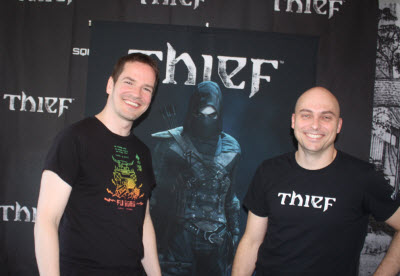GamesBeat: Your challenge, I guess, is making a game in the middle of a series that people like, and they want more of it, but they don’t want the exact same thing.
Gallagher: There are some pretty passionate fans out there still. The Thief franchise is good at creating that passion at a very deep level. I know some of the more passionate fans were worried about what we’re doing. But as I’ve said in other interviews, the old games are still available. You can still buy them and play them. They’re still a lot of fun. They’re also one, two, three and the story’s done.
We very clearly said to ourselves, “Okay, they are as good as they are. If you want to relive the old Thief experience, you can download that and play it again.” We have a new Thief with a new story. What I’ve started saying now is that if you look at it as separate like this, you have a whole new opportunity to fall in love with Garrett all over again.
GamesBeat: Did you feel that certain things were in need of a reboot? You said you’re bringing it back to where it was. Do you think it went astray in any ways that you wanted to fix or change to make this more appealing to new players or satisfying to old ones?
Gallagher: It’s a difficult one, because that’s always subjective.
Roy: Between the last Thief game and this one, 10 years will have passed. We’re in a position where, during those 10 years, the way we play games has changed a lot. We’ve seen a lot of evolution from players. They’re much more demanding. Story is a key element now. Back then, the story was there, but it was more of a mechanic-driven game. The first challenge, then, is to adapt the franchise for today’s gamer.
After that, for example, in the beginning we did a lot of focus groups and that sort of thing. 10 years ago, let’s say you’re in a garden and the guards see you. It wasn’t an automatic game over, but it was almost that bad. They’d chase you down like a rocket and kill you. When we did some focus tests, today’s gamers told us that, “Okay, this is a stealth game. I understand. I’m going to sneak around. But if they see me, I want to be able to fight. Give me something to fight back with.” That’s a difference now. Players are willing to play stealthy, but they expect to have something else too. We had to say, “Okay, how can we give you a feeling of empowerment?” At the same time, Garrett’s not a soldier. We don’t want to see him clearing a room with his fists. That’s the kind of challenge we’re facing.
GamesBeat: In that time, too, other franchises have evolved that way and created that expectation. Tom Clancy’s Splinter Cell: Blacklist is the one that comes to mind, where you can do heavy combat or heavy stealth. Players expect that mix and everyone else has to go along with it.
Gallagher: It’s hard to explain. I was going to say it’s become a “cultural norm,” but that’s not necessarily the case. I think people were surprised when — If you create a game and tell the player that when they get into trouble, the best thing to do is swoop off into the darkness and give yourself the advantage again, a lot of people’s first reactions were still to defend themselves. That’s what Stef was talking about, trying to bring something into the game that doesn’t compromise who Garrett is, that doesn’t break the universe, but enables people to defend themselves legitimately.
GamesBeat: As a designer, do you still want to reward the player who plays the game the way you’d like to see it played?
Roy: On our side, there’s no judgment, let’s say. If, in your opinion, this guy is a master thief and so the ghost style of gameplay is the right way to play, we want to build the game mechanics and the level design in a way that supports that. So it’s possible to finish the game without killing a guard. But if you’re more of a predatory player, that’s okay. I don’t want to tell you, “Because you killed these people, you don’t get any candy.” You’re still going to progress. When you’re choosing your upgrades, maybe you’ll pick more aggressive tools. That’s your choice.
At the end of each mission, we’re going to tell you what type of player you are. You’ll see a chart that explains, “Okay, in this mission you played in a more aggressive way,” or “In this mission you were the perfect ghost.” If you were perfectly stealthy through most of the mission, but the shit hit the fan once and you had to kill some guards, we’ll tell you, and you’ll have the chance to replay the mission how you like it again. It’ll be informational, not a judgment.
Gallagher: Another way of looking at it is that if you’re an aggressive player and you like the sound of an arrow and you like hitting somebody in the neck and you’re upgrading all the strong stuff, you’re giving yourself your own reward, because obviously you want to keep experiencing the game in this way.
What you tend to find is that the aggressive player will miss out in the rewards that the stealth guys get. They’re getting a lot of conversations. If you hang around in a room and you suddenly realize that people are speaking there about something, you can sit there for a half a minute thinking, “Ha, I had no idea they were going to say that.” You receive a very different reward, but it’s just as rewarding as this guy who’s having the roller-coaster ride of thwack-pow-wahoo!



